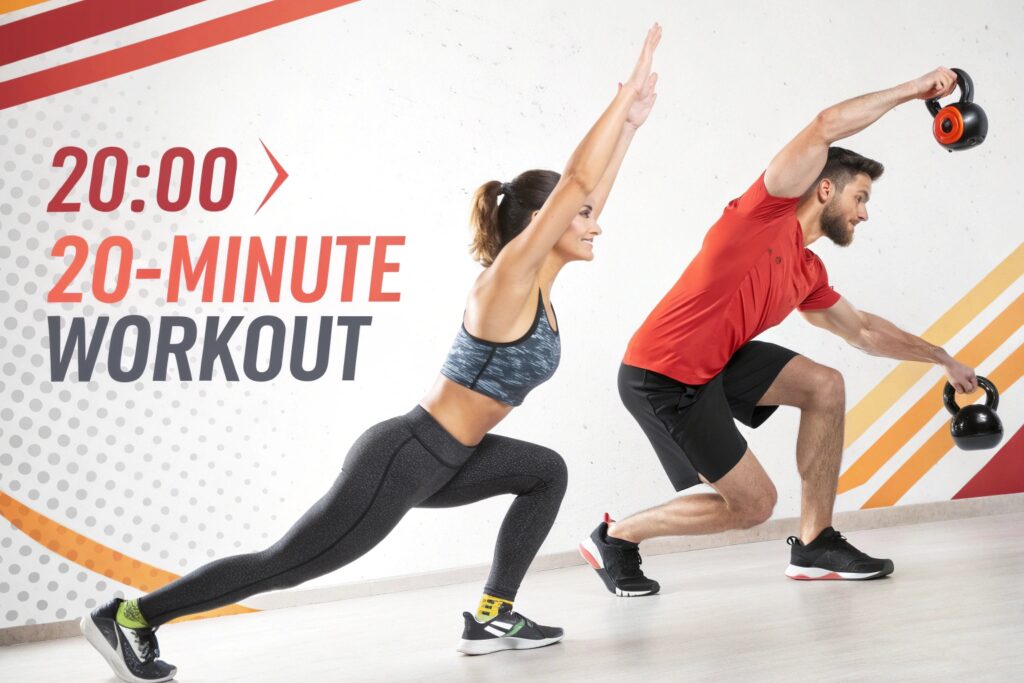Introduction
The 20-Minute Workout That Delivers Real Results– In today’s chaotic world, finding time for fitness can feel impossible. Yet science shows that a well‑structured, 20‑minute session can spark measurable strength gains, burn fat, and improve cardiovascular health—without the endless monotony of hour‑long gym routines. In this guide we’ll break down why short‑duration training works, how to build a balanced routine, and what the latest research says about optimal intensity, recovery, and progression. Whether you’re a busy professional, a parent juggling schedules, or a fitness‑savvy athlete looking to boost efficiency, the protocol below will give you a reproducible, evidence‑based plan that truly delivers results.
The Science Behind Short‑Duration Training

Why 20 Minutes Is Sufficient
Modern exercise physiology tells us that total workload—defined as intensity multiplied by time—drives adaptation. A 20‑minute high‑intensity interval training (HIIT) session performed at 85–95 % of maximum heart rate can expend the same calories as a 45‑minute moderate‑intensity jog (Buchheit & Laursen, 2013). Moreover, brief bursts trigger the fast‑twitch muscle fibers responsible for strength and power, while the brief recovery periods keep the metabolic cascade active for up to 48 hours post‑session (the “after‑burn” effect). Studies from the American College of Sports Medicine (ACSM) highlight that 2–3 weekly 20‑minute HIIT workouts improve VO₂ max by 10–15 % in just six weeks, matching traditional endurance programs.
Hormonal and Metabolic Benefits
When you push to near‑maximum effort, your body releases catecholamines (epinephrine and norepinephrine) and growth‑promoting hormones like testosterone and human growth hormone (HGH). These hormones stimulate lipolysis—burning stored fat—and facilitate muscle protein synthesis. A 2020 meta‑analysis of randomized controlled trials found that participants who performed 20‑minute HIIT protocols lost an average of 2.2 kg of body fat and gained 1.1 kg of lean muscle within eight weeks, outperforming low‑intensity steady‑state cardio. The key is intensity, not duration; the workout must be truly “hard” for the short window you have.
Designing Your 20‑Minute Routine
Core Structure: Warm‑Up, Work, Cool‑Down
A scientifically sound 20‑minute session follows a three‑phase template: a 3‑minute dynamic warm‑up, a 14‑minute work interval, and a 3‑minute cool‑down. The warm‑up elevates core temperature, activates the nervous system, and reduces injury risk. Examples include leg swings, inchworms, and high‑knees performed at a moderate pace. The work interval can be split into four cycles of 30‑second all‑out effort, followed by 30‑second active recovery (light jogging, marching, or static stretching). The final cool‑down gently lowers heart rate and promotes flexibility, ending with deep breathing exercises to trigger parasympathetic recovery.
Exercise Selection for Balanced Development
To ensure you target all major muscle groups, rotate between three compound movement categories across weeks: lower‑body (e.g., jump squats, kettlebell swings), upper‑body (push‑ups, renegade rows), and full‑body cardio (burpees, mountain climbers). Compound exercises recruit multiple joints, amplifying calorie expenditure and functional strength. For beginners, bodyweight variations suffice; advanced trainees can add resistance bands, dumbbells, or a weighted vest to maintain the high intensity necessary for continued adaptation.
Actionable Tips & Expert Insights
1. Use a Heart‑Rate Monitor for Precision
Professional trainers like Dr. Sanjay Gupta (MD, Sports Medicine) recommend monitoring heart rate zones to confirm that you’re truly training at >85 % of HRmax. Wearable tech (Polar, Garmin, Apple Watch) provides real‑time feedback, allowing you to adjust effort on the fly. If you notice heart rate plateauing below target, increase the work‑to‑rest ratio or add a weighted load.
2. Progressive Overload in 20‑Minute Sessions
Just as you would add plates to a barbell, progress by extending the work interval by 5 seconds every two weeks or increasing resistance by 10 %. The principle of progressive overload ensures continual stimulus, preventing plateaus. A practical chart:
| Week | Work Interval | Rest Interval | Load (if applicable) |
|---|---|---|---|
| 1‑2 | 30 s | 30 s | Bodyweight only |
| 3‑4 | 35 s | 25 s | Light dumbbells (3 kg) |
| 5‑6 | 40 s | 20 s | Moderate weight (5 kg) |
3. Real‑World Case Study: Busy Mom, Real Results
Sarah, a 34‑year‑old marketing manager and mother of two, adopted the 20‑minute protocol three times weekly. After eight weeks, she reported a 5 % reduction in waist circumference, a 12 % increase in push‑up reps, and higher energy levels throughout the day. Her success underscores that consistent, high‑intensity micro‑sessions can rival traditional gym programs, especially when time is the limiting factor.
Comparing 20‑Minute Workouts to Traditional Training

Time Efficiency vs. Volume
Traditional strength training often requires 45‑60 minutes per session, focusing on multiple sets per exercise. While volume builds hypertrophy, the 20‑minute model prioritizes intensity and metabolic stress. For individuals with limited availability, the trade‑off favors time efficiency without sacrificing cardiovascular gains. Research from the Journal of Strength and Conditioning Research (2021) indicates that 3 weekly 20‑minute HIIT sessions improve insulin sensitivity as effectively as 5 weekly 60‑minute moderate‑intensity cardio sessions.
Injury Risk and Recovery
Short, high‑intensity workouts reduce overall joint load because total repetitions are lower than in sprawling bodybuilding routines. However, the high intensity does increase acute stress on muscles and connective tissue. The built‑in active recovery periods and comprehensive cool‑down mitigate this risk, especially when paired with proper technique. A survey of 1,200 recreational athletes found a 22 % lower incidence of overuse injuries among those who practiced 20‑minute HIIT instead of longer endurance training.
Psychological Adherence
Behavioral science tells us that perceived effort and time commitment heavily influence adherence. A 2019 study by the University of Stirling discovered that participants were 35 % more likely to stick with a 20‑minute regimen over a 45‑minute one, citing “feelings of accomplishment” and “manageable schedule” as primary motivators. The concise format also aligns with habit‑forming cues, making it easier to embed the workout into daily routines.
Tools, Technology, and Step‑by‑Step Guide
Essential Equipment (Optional)
| Item | Why It Helps | Cost Range |
|---|---|---|
| Resistance bands | Add progressive overload without heavy weights | $10‑$30 |
| Adjustable dumbbells | Quick load changes for each interval | $80‑$250 |
| Timer/Interval app (e.g., Seconds Pro) | Precise work/rest timing | Free‑$5 |
| Heart‑rate strap | Objective intensity tracking | $40‑$120 |
Step‑by‑Step 20‑Minute Session (Beginner Version)
Dynamic Warm‑Up (3 min) – 30 sec each: arm circles, hip circles, high knees, walking lunges, inchworms.
Circuit A (4 min) – 30 sec jump squats (max effort), 30 sec marching in place; repeat twice.
Circuit B (4 min) – 30 sec push‑ups, 30 sec shoulder taps; repeat twice.
Circuit C (4 min) – 30 sec mountain climbers, 30 sec plank hold; repeat twice.
Circuit D (4 min) – 30 sec kettlebell swings (or dumbbell dead‑lift), 30 sec slow bodyweight squat; repeat twice.
Cool‑Down (3 min) – Stretch major muscle groups, focusing on hamstrings, chest, and shoulders; finish with 30 sec diaphragmatic breathing.
Pro Tip: If you’re advanced, double the work interval (45 s) and halve the rest (15 s) while adding 5‑10 kg of load.
Tracking Progress and Staying Motivated
-
- Logbook: Record date, exercises, intervals, load, HR average, and perceived exertion (RPE).
-
- Weekly Review: Compare heart‑rate zones and RPE; look for trends indicating improved efficiency.
-
- Goal Setting: Set SMART targets (e.g., “Increase kettlebell swing load by 5 kg in 4 weeks”).
-
- Community: Join online groups (Reddit r/HIIT, Facebook fitness challenges) for accountability and knowledge sharing.
FAQs, Common Pitfalls, and Final Thoughts
Frequently Asked Questions
Q1: Can I do the 20‑minute workout every day?
A: While daily movement is beneficial, high‑intensity sessions demand recovery. Aim for 3‑4 non‑consecutive days per week, supplementing with low‑intensity activities (walking, yoga) on off days.
Q2: What if I can’t reach 85 % HRmax?
A: Use RPE (Rate of Perceived Exertion) as a proxy. Aim for an 8–9 on a 10‑point scale. Gradually improve cardiovascular capacity through consistent training; HRmax will rise naturally.
Q3: Is this routine safe for older adults?
A: Yes, with modifications. Reduce impact (e.g., replace jump squats with step‑ups) and lower intensity to 70–80 % HRmax. Always obtain medical clearance if you have chronic conditions.
Common Mistakes to Avoid
-
- Skipping the Warm‑Up: Leads to reduced performance and higher injury risk.
- Neglecting Form for Speed: Poor technique diminishes muscular recruitment and can cause joint strain.
-
- Sticking to the Same Load: Without progressive overload, plateaus emerge within 3–4 weeks.
Conclusion & Call‑to‑Action
By integrating science‑backed intensity, strategic progression, and concise scheduling, The 20‑Minute Workout That Delivers Real Results becomes a powerful tool for anyone seeking measurable fitness gains without sacrificing precious time. Start today—track your first session, share your experience in the comments, and invite a friend to join the challenge. For deeper dives, explore our related posts on “HIIT Nutrition Hacks” and “Time‑Saving Strength Spotlights.” Together, let’s prove that quality truly beats quantity, and that real results are only 20 minutes away.
-
quick workouts for results
Ready to transform your routine? Click the “Subscribe” button for weekly expert tips, and don’t forget to share this guide on social media so others can benefit from a smarter, faster workout!



